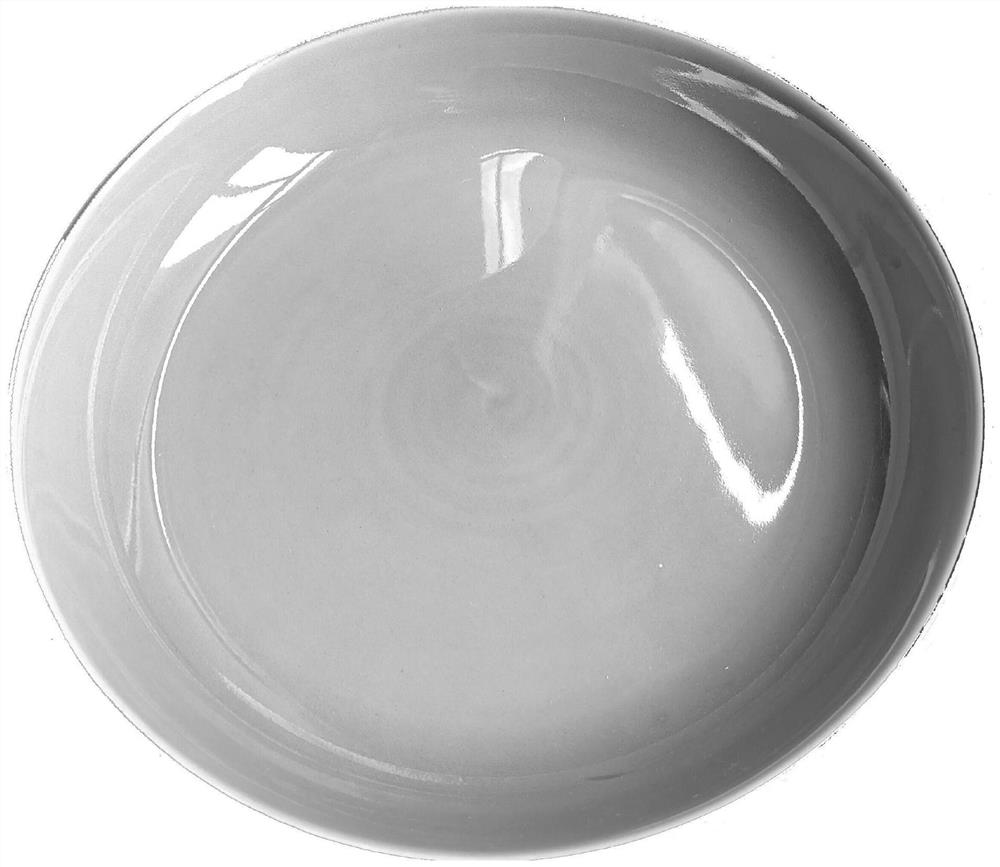Low-cost antibacterial ceramic glaze and preparation method thereof
A low-cost technology for antibacterial ceramics, applied in the field of ceramics, can solve the problems of poor material stability, low utilization rate, and high cost of antibacterial agents, and achieve the effect of low cost, relatively low cost, and easy access
- Summary
- Abstract
- Description
- Claims
- Application Information
AI Technical Summary
Problems solved by technology
Method used
Image
Examples
Embodiment 1
[0028] In parts by weight, the composition of the antibacterial ceramic glaze includes: SiO 2 51.5 parts, Al 2 o 3 is 8.5 parts, Na 2 O is 1.0 parts, CaO is 6.3 parts, K 2 O is 4.1 parts, TiO 2 7 parts for ZnO, 14 parts for ZnO, 3.9 parts for BaO, 0.5 parts for MgO, 2.5 parts for CuO, and less than 0.7 parts for other components.
[0029] Specifically, the following raw materials are used:
[0030] 42 parts of feldspar powder with fineness below 325 mesh, 22 parts of quartz powder with fineness below 250 mesh, 12 parts of calcite powder with fineness below 250 mesh, 1 part of refined Suzhou soil, 14 parts of zinc oxide, fineness of 2 parts of dolomite below 250 mesh, 5 parts of barium carbonate, 7 parts of titanium dioxide, and 2.5 parts of copper oxide. The above-mentioned parts are all parts by weight.
[0031] The preparation method of antibacterial ceramic glaze comprises the steps:
[0032] Firstly, the raw materials zinc oxide and titanium dioxide are pre-calcine...
Embodiment 2
[0040] 41 parts of feldspar powder with fineness below 325 mesh, 22 parts of quartz powder with fineness below 250 mesh, 15 parts of calcite powder with fineness below 250 mesh, 1 part of refined Suzhou soil, 13 parts of zinc oxide, fineness of 2 parts of dolomite below 250 mesh, 7 parts of barium carbonate, 8.5 parts of titanium dioxide, and 3.5 parts of copper oxide.
[0041] The pre-calcination of the raw materials zinc oxide and titanium dioxide is the same as in Example 1.
[0042] The preparation method of antibacterial ceramic glaze comprises the steps:
[0043] (1) Preparation of glaze slurry
[0044] Mix glaze raw materials, balls, and water in a weight ratio of 1:1.5:1, wet ball mill through a ball mill, and pass through a 250-mesh sieve. When the sieve residue is 0.08%, the specific gravity of the glaze slurry is 1.42.
[0045] (2) Glazing
[0046] The above-mentioned glaze slurry is applied to a ceramic bisque body with a water absorption rate of 14.6% to form a...
Embodiment 3
[0050] 44 parts of feldspar powder with fineness below 325 mesh, 25 parts of quartz powder with fineness below 250 mesh, 11 parts of calcite powder with fineness below 250 mesh, 2 parts of refined Suzhou soil, 14.5 parts of zinc oxide, fineness of 4 parts of dolomite below 250 mesh, 6 parts of barium carbonate, 9 parts of titanium dioxide, and 2 parts of copper oxide.
[0051] The pre-calcination of the raw materials zinc oxide and titanium dioxide is the same as in Example 1.
[0052] The preparation method of antibacterial ceramic glaze comprises the steps:
[0053] (1) Preparation of glaze slurry
[0054] Mix glaze raw materials, balls, and water in a weight ratio of 1:1.5:1, wet ball mill through a ball mill, and pass through a 250-mesh sieve. When the sieve residue is 0.12%, the specific gravity of the glaze slurry is 1.50.
[0055] (2) Glazing
[0056] The above-mentioned glaze slurry is applied on a ceramic bisque body with a water absorption rate of 12.3%, forming a g...
PUM
| Property | Measurement | Unit |
|---|---|---|
| thickness | aaaaa | aaaaa |
| water absorption | aaaaa | aaaaa |
| antibacterial rate | aaaaa | aaaaa |
Abstract
Description
Claims
Application Information
 Login to View More
Login to View More - R&D
- Intellectual Property
- Life Sciences
- Materials
- Tech Scout
- Unparalleled Data Quality
- Higher Quality Content
- 60% Fewer Hallucinations
Browse by: Latest US Patents, China's latest patents, Technical Efficacy Thesaurus, Application Domain, Technology Topic, Popular Technical Reports.
© 2025 PatSnap. All rights reserved.Legal|Privacy policy|Modern Slavery Act Transparency Statement|Sitemap|About US| Contact US: help@patsnap.com

